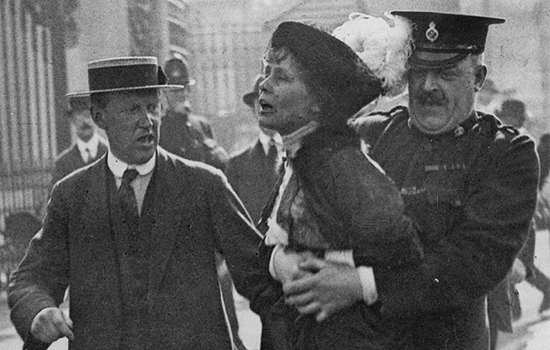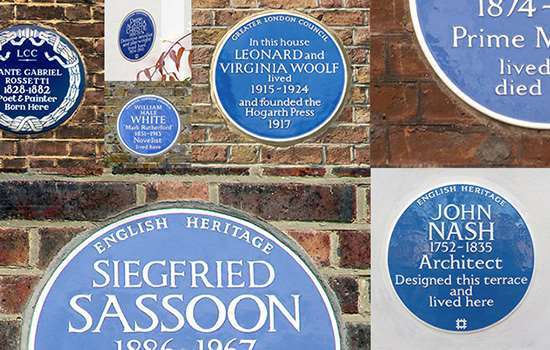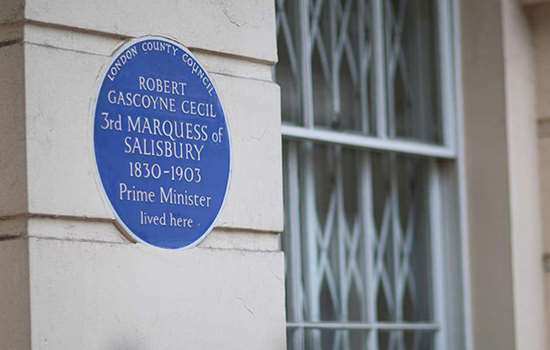BLYTON, Enid (1897-1968)
Plaque erected in 1997 by English Heritage at 207 Hook Road, Chessington, KT9 1EA, Royal Borough of Kingston Upon Thames
All images © English Heritage
Profession
Children's Writer
Category
Literature
Inscription
ENID BLYTON 1897-1968 Children's Writer lived here 1920-1924
Material
Ceramic
Among the most prolific and successful children’s authors ever, Enid Blyton is best known for the fictional creations of Noddy, the Famous Five and the Secret Seven. A blue plaque commemorates her former home at 207 Hook Road in Chessington, where she started to develop her storytelling skills.
‘THE FOUNDATION OF ALL MY SUCCESS’
Born in East Dulwich, Blyton turned to writing in her teens, but decided in 1915 to train as a teacher. In January 1920 she was employed as a governess by Horace and Gertrude Thompson at 207 Hook Road, then known as Southernhay. The Thompsons’ four sons – David, Brian, Peter and John – were Blyton’s charges until she left in April 1924. She married Hugh Pollock, the first of her two husbands, that August.
It was while at Southernhay – where she was given her own small room at the back of the house – that Blyton started to develop her children’s stories. She later wrote to Brian of being ‘so happy’ at the house, and described her time there as ‘the foundation of all my success’.
EARLY INSPIRATION
Blyton’s charges were quickly joined by other local children, forming a small ‘school’, and it was on this group that she ‘practised’ writing and reciting plays, poems and songs for their education and enjoyment. The group, in turn, provided her with further inspiration. Locking her door when the day’s duties were done, she produced works including her first success, the poetry collection Child Whispers (1922).
SUCCESS
A full-time writer from 1924, Blyton was extraordinarily prolific: her total output was around 650 volumes. From 1926 she began editing a magazine, Sunny Stories, in which many of her characters first appeared. Her first full-length story book was Adventures of the Wishing Chair (1937): her ‘fairy stories’ of this era, including The Enchanted Wood (1939) have since been said to represent some of her best work.
The Naughtiest Girl in the School (1940) was her first school story, and was followed by the St Clare’s and Malory Towers school series. The first Famous Five book arrived in 1942, and was followed by 20 more. Its heroes – the siblings Julian, Dick and Anne, their tomboy cousin Georgina (‘George’) and Timmy the dog – intrepidly investigated mysteries and wrongdoers, often in the face of adult indifference. The series spawned film and television adaptations – and, later, a series of lampoons by the Comic Strip, beginning with Five Go Mad in Dorset (1982).
Similar ‘detective’ plot themes feature in the Secret Seven, a series that launched in 1949. The same year saw the advent of Noddy, illustrated by the Dutch artist Harmsen van der Beek. The adventures of this wooden doll and his friends in Toyland – aimed at younger children – stretched across some 23 books, and launched a merchandising empire of toys, games, clothing and other items that made him Blyton’s most lucrative creation.
The majority of Blyton’s books were written at Green Hedges, Beaconsfield, Buckinghamshire, her home from 1938, which has now been demolished.
CRITICISM
Both during her lifetime and after, Blyton’s work has been criticised for various aspects of its content. Its formulaic plots and deliberate use of simple language irked some educators.
Others took exception to what they perceived as social snobbery, racism and sexism embedded in Blyton’s storylines. In 1960 the publisher Macmillan refused to publish her story The Mystery That Never Was for what it called its ‘faint but unattractive touch of old-fashioned xenophobia’. The book, however, was later published by William Collins. In recent years, references to ‘gollywogs’ in Blyton’s stories have been replaced by goblins.
To those who objected to elements of her work, Blyton replied that the opinion of any critic over 12 years old did not interest her, and she successfully took legal action against a librarian who repeated the persistent story that her prolific output was enabled by a squad of ghost writers.
COMMEMORATION
Blyton died in a Hampstead nursing home aged 71. A detailed critical treatment of her work appeared in 2000 and Enid, a TV biopic starring Helena Bonham-Carter, first aired in 2009. As well as the English Heritage plaque in Chessington, Blyton has also been commemorated by other bodies at her former addresses in Dulwich, Beckenham and Beaconsfield. In her centenary year of 1997, the Royal Mail produced a series of commemorative stamps. In 2016, however, the Royal Mint decided against commemorating Blyton on a 50p coin because of concerns about some of her alleged views.
While criticisms of Blyton cannot be entirely dismissed, her work has encouraged generations of children to read. It continues – sometimes in revised form – to sell in considerable quantities. According to UNESCO, she remains the fourth most translated author in the world, after Agatha Christie, Jules Verne and Shakespeare.
Further reading
S Ray, ‘Enid Blyton’, Oxford Dictionary of National Biography (Oxford, 2017) (access via public library membership; accessed 30 June 2021)


